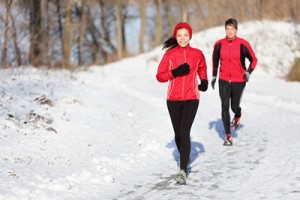 With resolution time scheduled right in the middle of an annual deep freeze, we’re really not setting ourselves up for success—at least when it comes to popular fitness aspirations like running a marathon or triathlon. Right as we’re most motivated to hit the ground running, the ground’s suddenly covered in a foot of snow. But, short of switching our goal-setting holiday to Arbor Day, there is actually a solid list of training tactics you can employ indoors that go miles towards improving power, speed, and allover race performance, says Joel Ramirez, director of the Bay Club Company’s BreakAway Performance program. And no, they’re not all about spending mind-numbing hours on the hamster wheel.
With resolution time scheduled right in the middle of an annual deep freeze, we’re really not setting ourselves up for success—at least when it comes to popular fitness aspirations like running a marathon or triathlon. Right as we’re most motivated to hit the ground running, the ground’s suddenly covered in a foot of snow. But, short of switching our goal-setting holiday to Arbor Day, there is actually a solid list of training tactics you can employ indoors that go miles towards improving power, speed, and allover race performance, says Joel Ramirez, director of the Bay Club Company’s BreakAway Performance program. And no, they’re not all about spending mind-numbing hours on the hamster wheel.
With its first Pro Lab now open at Bay Club San Francisco, the race training program headed by Ramirez offers coaching and strategies to clients looking to take their swimming, biking or running performance to the next level. (Lucky for them, BreakAway’s recent acquisition by the Bay Club family of active lifestyle resorts means that athletes and beginners alike can take advantage of this elite-caliber training from the comfort of a full-service club, with amenities ranging from childcare to spa to wine club.) Here are Ramirez’s top ten tips for coming out of blizzard season on track to achieve a PR:
1. Keep off the ice. Unless you’re cross-training in skates. Running or biking in poor conditions isn’t hardcore; it’s just a good way to fall and sideline yourself from the spring race you already registered for. Yes, this is the one tip telling you to hit the treadmill or stationary bike. Try a set of 10 x 400 intervals; intervals train the body to buffer lactic acid, improving recovery times. Make sure to rest adequately between sets.
2. Hire a coach. “Even if you think you know everything, a trained set of eyes can find hidden opportunities for improvement,” says Ramirez. A good coach will make sure you train your weaknesses and race your strengths. Plus, you can do your initial consultation and diagnostic sessions from the cozy warmth of the gym.
3. Establish a baseline. Speaking of diagnostics, they’re not just for congratulating yourself upon looking back at how far you’ve come. A coach will use them to determine the optimal steady-as-she-goes program for you to achieve the results you want. Winter training is a critical time to rack up base mileage in order to build a solid foundation from which you can later build up your speed without injuries.
4. Plan your attack. Work canceled? A snow day is the perfect time to hammer out your macro cycle program—that is, your master training plan for the year. Include several preliminary races (your “B” and “C” events) before the big one and plan out your season so that you peak just at the right time for your “A” race.
 5. Pump you up. Contrary to the stereotype of the muscle-bound lunk who can barely move, strength-training actually boosts horsepower and quickness in racers. Just twenty minutes of strength training a couple days a week will develop the fast-twitch type 2 muscle fiber you need to shave minutes off your PR.
5. Pump you up. Contrary to the stereotype of the muscle-bound lunk who can barely move, strength-training actually boosts horsepower and quickness in racers. Just twenty minutes of strength training a couple days a week will develop the fast-twitch type 2 muscle fiber you need to shave minutes off your PR.
6. Bend it like Buddha. Yoga (especially “power yoga”) improves flexibility, stabilization and range of motion, which are crucial for proper swim, bike and run biomechanics. And, it’s done in a toasty studio.
7. Cross the aisle. To the rowing machines. Cross-training with different cardio, kickboxing, racquetball—whatever—can help keep fitness levels up in the off-season and and burnout levels low. “Olympians and professionals do it; so should you!” says Ramirez. Polar vortex bonus: Shoveling snow works in a pinch.
8. Find Zen (or just the art of cycle maintenance). Plug in a space heater in the garage and bone up on bike mechanics so you’re not caught with your spandex down during the race. “What good is a super-fast swim-to-bike transition if rubbing brakes are robbing time?” says Ramirez.
9. Preheat your kitchen. It’s all too common to gain weight during the off season, especially if you follow every training session with enough food to feed the Olympic village. Higher-end health clubs may have an on-staff nutritionist (as the Bay Club does) who can help you design an eating plan focused on losing weight if appropriate and maximizing your power-to-weight ratio.
10. Take a load off. Don’t wait till you literally cannot get to the gym (because your car is still on the interstate where you abandoned it during an ice storm) to take a break. Regular rest days are absolutely required for progressing in your sport. Recovery periods are when muscles repair themselves and grow stronger. So kick off your sneaks, make some cocoa, tune in to the round-the-clock weather coverage…and know you’re right on task with your training goals.
About The Bay Club Company
Founded in 1977, The Bay Club Company (formerly Western Athletic Clubs) owns and operates six regional campuses from Marin County to San Diego, The Bay Club Company provides its members with the finest quality active lifestyle experiences. For 35 years, the Company has maintained the highest standards of professional service, earning a reputation as one of the leading private club companies in the United States. The Company employs approximately 2,000 people and is headquartered in San Francisco, California. For more information, visit www.bayclubs.com.
